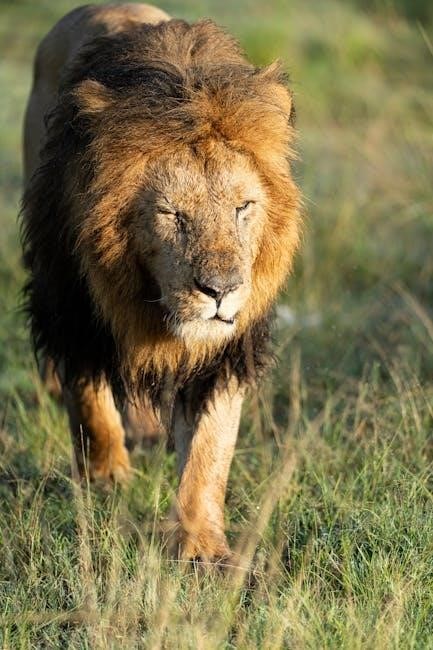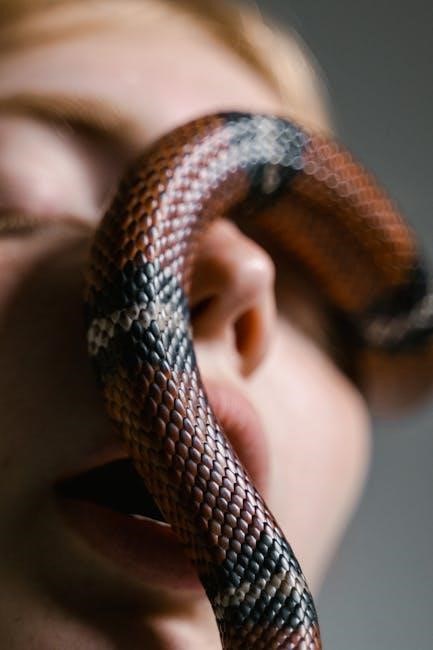Chapter 10 Dihybrid Cross Worksheet Answer Key PDF: A Comprehensive Guide
This comprehensive guide provides answer keys for dihybrid cross worksheets, focusing on understanding and solving genetics problems. It is designed to help students master concepts, analyze genotypes/phenotypes, and predict offspring traits using Punnett squares. Real-world examples like rabbits, peas, and guinea pigs are included.
Dihybrid crosses represent a fundamental concept in genetics, extending Mendelian inheritance principles to the simultaneous analysis of two distinct traits. Unlike monohybrid crosses, which focus on the inheritance pattern of a single trait, dihybrid crosses explore how two different genes, each with two or more alleles, are transmitted from parents to offspring. This approach allows for a more complex understanding of genetic inheritance and the potential combinations of traits that can arise in subsequent generations.
At its core, a dihybrid cross involves parents that are heterozygous for both traits under consideration. This means each parent carries two different alleles for each of the two genes. Understanding dihybrid crosses requires a solid grasp of basic genetic terminology, including genotypes (the genetic makeup of an organism) and phenotypes (the observable characteristics resulting from the genotype). The use of Punnett squares becomes essential for predicting the possible genotypes and phenotypes of offspring, allowing for the calculation of probabilities for each combination.
Furthermore, dihybrid crosses illustrate the principle of independent assortment, one of Mendel’s key contributions to genetics. This principle states that the alleles of different genes assort independently of one another during gamete formation. In other words, the inheritance of one trait does not affect the inheritance of another, provided the genes for those traits are located on different chromosomes. By studying dihybrid crosses, students can gain a deeper appreciation for the complexity and elegance of genetic inheritance and its role in shaping the diversity of life.
Understanding Genotypes and Phenotypes in Dihybrid Crosses
In the realm of genetics, distinguishing between genotype and phenotype is crucial, especially when analyzing dihybrid crosses. The genotype refers to the specific combination of alleles an organism possesses for a particular trait. For a dihybrid cross, this involves considering the alleles for two different genes. For instance, if we’re examining hair color (G for gray, g for white) and eye color (B for black, b for red) in rabbits, a possible genotype could be GgBb, indicating heterozygosity for both traits.
Conversely, the phenotype is the observable expression of these genes – the physical characteristics we can see. In our rabbit example, a GgBb genotype would result in a rabbit with gray hair and black eyes, assuming gray and black are dominant traits. Understanding the relationship between genotype and phenotype is fundamental to predicting the outcomes of dihybrid crosses.
When solving dihybrid cross problems, it’s essential to first identify the genotypes of the parents and then determine the possible allele combinations they can pass on to their offspring through their gametes. This involves understanding dominant and recessive relationships. Dominant alleles mask the expression of recessive alleles when present together. The Punnett square then serves as a visual tool to map out all potential combinations of these gametes, allowing us to predict the genotypic and phenotypic ratios in the offspring generation. Accurately interpreting these ratios is key to mastering dihybrid crosses.

Rabbit Example: Hair and Eye Color Inheritance
To illustrate dihybrid crosses, let’s consider the inheritance of hair and eye color in rabbits. Suppose gray hair (G) is dominant over white hair (g), and black eyes (B) are dominant over red eyes (b). We can use this example to understand how two traits are inherited simultaneously.
Imagine we cross two rabbits, both heterozygous for both traits (GgBb). This means each parent has one allele for gray hair and one for white hair, as well as one allele for black eyes and one for red eyes. To predict the possible offspring, we need to consider all possible combinations of alleles that each parent can contribute.

Each parent can produce four types of gametes: GB, Gb, gB, and gb. By constructing a 4×4 Punnett square, we can visualize all the possible combinations of these gametes. The Punnett square will show a variety of genotypes, such as GGBB, GGBb, GgBB, GgBb, GGbb, Ggbb, ggBB, ggBb, and ggbb. Each genotype corresponds to a specific phenotype. For example, GGBB, GGBb, GgBB, and GgBb all result in rabbits with gray hair and black eyes. GGbb and Ggbb will have gray hair and red eyes. ggBB and ggBb will have white hair and black eyes. Finally, ggbb will have white hair and red eyes. Analyzing the ratios of these phenotypes allows us to understand the inheritance patterns of these two traits.
Setting up Punnett Squares for Dihybrid Crosses
Setting up Punnett squares for dihybrid crosses involves organizing the possible allele combinations from each parent. In a dihybrid cross, we’re tracking two different genes, each with two alleles. The key is to determine the gametes each parent can produce.
For example, consider a plant with alleles RrYy, where R represents round seeds (dominant) and r represents wrinkled seeds (recessive), while Y represents yellow seeds (dominant) and y represents green seeds (recessive). This plant can produce four types of gametes: RY, Ry, rY, and ry.
To construct the Punnett square, create a 4×4 grid. List the possible gametes from one parent across the top and the possible gametes from the other parent down the side. Each cell in the Punnett square represents a possible offspring genotype, formed by combining the alleles from the corresponding row and column. For example, the cell where the ‘RY’ gamete from one parent meets the ‘ry’ gamete from the other parent will contain the genotype RrYy. Filling in all the cells provides a complete overview of potential offspring genotypes. This allows us to then determine the phenotypic ratios, predicting the probability of each trait combination in the offspring generation. Careful setup is crucial for accurate predictions.
Step-by-Step Problem Solving for Dihybrid Crosses

Solving dihybrid cross problems requires a systematic approach; First, identify the traits involved and their corresponding alleles, noting which are dominant and recessive. Assign letters to represent each allele, using uppercase for dominant and lowercase for recessive. Next, determine the genotypes of the parents. This may be explicitly given or inferred from the problem statement.
Once you have the parental genotypes, determine all possible gamete combinations each parent can produce using the FOIL method (First, Outer, Inner, Last). Construct a 4×4 Punnett square, listing the gametes from one parent along the top and the gametes from the other parent down the side.
Fill in each cell of the Punnett square by combining the alleles from the corresponding row and column, representing the potential offspring genotypes. After completing the Punnett square, determine the phenotypic ratios by counting the number of offspring with each trait combination. Simplify the ratios to their lowest terms. Finally, interpret the results to answer the specific question posed in the problem, such as the probability of a certain phenotype appearing in the offspring. Consistent practice is essential for mastering these steps.
Example Problems and Solutions: Determining Offspring Genotypes and Phenotypes

Let’s illustrate dihybrid cross problem-solving with examples. Consider a cross between pea plants, where ‘T’ represents tallness (dominant) and ‘t’ represents shortness (recessive), and ‘Y’ represents yellow seeds (dominant) and ‘y’ represents green seeds (recessive). A plant with genotype TtYy is crossed with another TtYy plant. To determine the offspring genotypes and phenotypes, we construct a Punnett square.
The TtYy plant can produce TY, Ty, tY, and ty gametes. Filling the Punnett square, we find various genotypes like TTYY, TTYy, TtYY, TtYy, TTyy, Ttyy, ttYY, ttYy, and ttyy. Analyzing the phenotypes, we observe that tall plants with yellow seeds (T_Y_) occur in 9/16 of the offspring, tall plants with green seeds (T_yy) in 3/16, short plants with yellow seeds (ttY_) in 3/16, and short plants with green seeds (ttyy) in 1/16. Therefore, the phenotypic ratio is 9:3:3:1.
Another example involves a cross between a TTYy plant and a ttyy plant. The Punnett square shows only TtYy and Ttyy offspring, resulting in a 1:1 phenotypic ratio of tall plants with yellow seeds to tall plants with green seeds. These examples demonstrate how Punnett squares help predict offspring genotypes and phenotypes.
Practice Problems: Predicting Offspring Traits
Sharpen your dihybrid cross skills with these practice problems. Imagine guinea pigs where black fur (B) is dominant to brown fur (b), and coarse hair (C) is dominant to smooth hair (c). Cross a heterozygous black, heterozygous coarse-haired guinea pig (BbCc) with a brown, smooth-haired guinea pig (bbcc). Construct the Punnett square and determine the phenotypic ratio of the offspring.
Next, consider pea plants again. This time, yellow seeds (Y) are dominant to green seeds (y), and round seeds (R) are dominant to wrinkled seeds (r). Perform a cross between a plant heterozygous for both traits (YyRr) and a plant homozygous recessive for both traits (yyrr). What proportion of the offspring will have green, wrinkled seeds?
For a more challenging problem, think about rabbits where gray hair (G) is dominant to white hair (g), and black eyes (B) are dominant to red eyes (b). Cross a rabbit heterozygous for both traits with a rabbit that is homozygous recessive for hair color and heterozygous for eye color (ggBb). What are the possible genotypes and phenotypes of the offspring, and what is the probability of obtaining a rabbit with white hair and black eyes?
Dihybrid Crosses in Other Organisms (e.g., Guinea Pigs, Peas)
Dihybrid crosses aren’t limited to rabbits; they apply to various organisms. Consider guinea pigs, where coat color and hair texture are key traits. Black fur (B) is dominant to brown fur (b), and coarse hair (C) is dominant to smooth hair (c). A cross between two heterozygous individuals (BbCc x BbCc) will produce a range of offspring phenotypes, illustrating the independent assortment of these traits.
Pea plants, famously studied by Mendel, also demonstrate dihybrid inheritance. Yellow seeds (Y) are dominant to green seeds (y), and round seeds (R) are dominant to wrinkled seeds (r). Crossing a plant with genotype YyRr with another of the same genotype will yield offspring with varying combinations of seed color and shape, showcasing the 9:3:3:1 phenotypic ratio characteristic of dihybrid crosses.
These examples highlight the universality of dihybrid crosses in genetics, reinforcing the principles of independent assortment and the prediction of offspring traits based on parental genotypes. Understanding these crosses in different organisms deepens comprehension of genetic inheritance.
Dominant and Recessive Alleles in Dihybrid Crosses
Dihybrid crosses involve tracking two different traits simultaneously, each governed by a pair of alleles. In these crosses, understanding the relationship between dominant and recessive alleles is crucial for predicting offspring phenotypes. A dominant allele masks the expression of a recessive allele when both are present in an individual’s genotype.
Consider a dihybrid cross involving pea plants, where seed color (yellow or green) and seed shape (round or wrinkled) are the traits of interest. If yellow (Y) is dominant to green (y) and round (R) is dominant to wrinkled (r), an individual with the genotype YyRr will exhibit yellow, round seeds. Only individuals with the homozygous recessive genotype (yyrr) will display the green, wrinkled phenotype.
When constructing Punnett squares for dihybrid crosses, it’s essential to correctly identify and represent the dominant and recessive alleles for each trait. This understanding allows for accurate prediction of the phenotypic ratios in the offspring generation, typically resulting in a 9:3:3:1 ratio when both parents are heterozygous for both traits.
Applications of Dihybrid Crosses in Genetics
Dihybrid crosses are foundational in genetics, with broad applications in understanding inheritance patterns and predicting traits in various organisms. These crosses are invaluable in agriculture for crop improvement, allowing breeders to select for desirable combinations of traits such as disease resistance and high yield.
In animal breeding, dihybrid crosses aid in predicting and selecting for specific characteristics, like coat color and size, improving livestock quality. Furthermore, dihybrid crosses are crucial in genetic research, helping scientists unravel complex inheritance mechanisms and gene interactions. By analyzing the phenotypic ratios in offspring, researchers can infer the genotypes of parents and understand the relationship between different genes.
Moreover, dihybrid crosses provide insights into genetic diversity and evolution, demonstrating how multiple genes contribute to the variation observed within populations. This knowledge is vital for conservation efforts, enabling scientists to manage genetic resources and prevent the loss of valuable traits. Dihybrid crosses remain a cornerstone of genetic studies, contributing to advancements in medicine, agriculture, and our understanding of life itself.
Resources for Further Study and Practice
To deepen your understanding of dihybrid crosses, numerous resources are available for study and practice. Online platforms like Khan Academy and Biology LibreTexts offer comprehensive lessons, interactive simulations, and practice quizzes to reinforce key concepts. Textbooks and study guides dedicated to genetics often include detailed explanations of dihybrid crosses, along with step-by-step problem-solving techniques.
Worksheet generators and online Punnett square calculators can help you create customized practice problems and check your work. Many educational websites provide free dihybrid cross worksheets with answer keys, allowing you to test your knowledge and identify areas for improvement. Additionally, virtual labs and simulations allow you to conduct dihybrid cross experiments in a risk-free environment, enhancing your understanding of the underlying principles.
Consider joining online study groups or forums to discuss challenging concepts and collaborate with peers. Finally, exploring scientific articles and research papers related to genetics can provide a deeper insight into the real-world applications of dihybrid crosses, solidifying your understanding of this essential topic.







